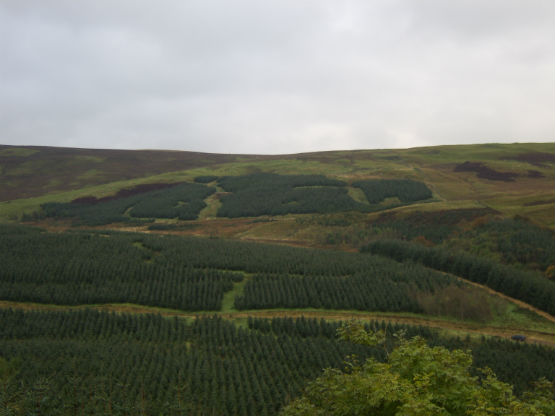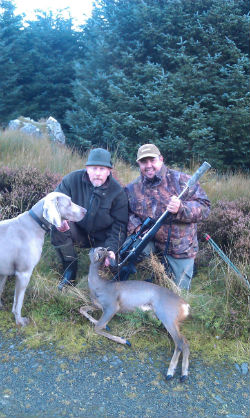Chris Dalton discusses the challenges of Stalking & Managing Roe Deer in Scotland.

In the area of Scotland we manage, amongst the hills of South Ayrshire, I am finding that the Roe bucks are around 3 weeks behind an average season, and this seems to tie in with everything else – early potatoes and the Spring barley and late grass and so on . May is always a great month for some real quality Roe buck Stalking and the vegetation is not too bad, along with a lack of midges!
So how do we go about managing our Roe buck and selecting which beast to shoot and when? The key to any deer management starts with your females. Does form the basis of our deer management plans. We want to maintain a healthy number in balance with the type of ground they are on and at a density which does not bring them into conflict with the commercial aspect of the ground, be that timber or agricultural crops. You don’t need to worry too much about the number of bucks are far as the females go! If your does can’t find a suitable buck on your ground then rest assured they will find one!! They will even go and fetch him if they can’t entice him to their boudoir, you can be sure of that.
However, that’s not to say we don’t include bucks in our cull plans, we most certainly do and having taken the time and trouble to get our female population right we do the same for the males. Ideally, we want a reasonable number of mature and dominant Roe buck holding territories on our ground and to maintain that, a number of potential replacements coming through; you have to allow these boys room though. They will co-habit given sufficient room to keep out of each other’s way. But how often do I hear that if we leave the does alone then we will have lots of bucks next year, and if we shoot them lightly we have loads of really nice 6 point bucks at the 2 and 3 year point? Well you won’t, you will just create a problem. The way to produce a good trophy head is to have a good balanced population of both sexes; this in turn will reduce competition for food and conflict between the deer.
 The situation Tony and I face stalking across our areas in the South West of Scotland, is that our ground is mainly commercial forestry, both broadleaf and conifer. Therefore our primary responsibility to the owners and forestry companies who own or manage the ground we stalk, is to ensure that deer damage to these trees is maintained at an acceptable level, and in particular, to protect the young and newly planted trees which are at their most vulnerable until they can get going. Time of year is also relevant to deer damage. In winter for example, when food can be hard to find all deer will love a crop of tasty young shoots, usually the type a kindly forester has spent days planting for them in a lovely clear area, and where they can browse away quite happily under cover of darkness!
The situation Tony and I face stalking across our areas in the South West of Scotland, is that our ground is mainly commercial forestry, both broadleaf and conifer. Therefore our primary responsibility to the owners and forestry companies who own or manage the ground we stalk, is to ensure that deer damage to these trees is maintained at an acceptable level, and in particular, to protect the young and newly planted trees which are at their most vulnerable until they can get going. Time of year is also relevant to deer damage. In winter for example, when food can be hard to find all deer will love a crop of tasty young shoots, usually the type a kindly forester has spent days planting for them in a lovely clear area, and where they can browse away quite happily under cover of darkness!
But another key time for damage is May, the culprit is the roe buck. Firstly, we have them cleaning the velvet, fraying and rubbing on trees branches and stems at a convenient height. At ‘Garryloop’, Anne and I like to see deer about the house and we have landscaped the grounds. I have some seven year old fruit trees planted at the top of my field, half of them are dead, bark rubbed off, and the survivors have no lateral branches below around 4 feet causing them to bush out like lollipops. All due to Roe buck activity, mainly in the early Spring.
When the antlers are clean, they begin to get really territorial and start thrashing around the same trees like a Gladiator preparing for battle, marking and practising their moves ready for sorting out that young rival buck around the corner. None of this is going to make you popular with your landlord, trust me!
Action has to be taken, but your work in this department should have begun some months ago. The best time for this is late winter and into early Spring. Cover is down, its cold they need to feed and start to regain condition, some nutrient is coming through in the form of shoots and buds and so you can find out who is about and where. You can build a picture of you dominant bucks and where the youngsters are and get a good idea of numbers, so allowing formulation your cull plan.
Infact March is a great month for this, we are shooting very little now, perhaps the odd follower, so while we are out maintaining seats, building towers and the like we are really getting to spend time on the ground and assessing the deer in each area. So by now you know what you want to do and achieve in relation to the individual requirements of your own blocks and ground. You won’t go far wrong following a similar cull ratio to the does, around 60 % young ( kids born last year ) to 20 % each old and mature.
This is very much what we do, but we do hit the youngsters hard from the off, and that’s vital, but if we see a buck of poor quality or with poor/miss shaped head then he will go too. The season will quickly move on, these deer will learn rapidly, they are a quarry species and will become harder to find , all compounded by the inevitable explosion of the cover and bracken and before you know it you are behind.
Later on, after they are clean, we can decide which of the better bucks to leave and which to shoot, if the numbers required for your cull remain high and your time is limited, you may not be allowed this luxury and just have to take your chance as it comes. Also other land factors may be a factor, game rearing interests might require you to get the bucks sorted before July and pens are occupied.
You have to work within your own constraints. But the key factor is to leave your dominant buck alone; he will go a long way to keeping your other bucks in order. He won’t stand any nonsense from the troublemakers and will see off young bucks and you will find your fraying damage is much reduced. If you don’t think so, shoot one of your dominant bucks in early April and see the increase in fraying and territorial marking that rapidly appears on the old boys patch as the contenders for the throne start to vie for power!
This policy works for us, a gold medal roe shot by me in Ayrshire in August demonstrates this and as explained, we are primarily involved in protecting the crop from deer. However, the methods we use to achieve this come from sound deer management principals, and whilst we do not have the luxury of selecting and nurturing bucks to produce the maximum number of trophy animals at premium rates for a purely sporting estate, we are producing trophy animals and have a healthy herd.
Most of you will, I am sure, be in a similar position to us with responsibility to a land owner for deer damage, so rather than just going out this month and shooting a buck or two, why not start to manage your deer and formulate a plan to this effect. It really isn’t rocket science! Look at your situation, the layout of the land and factors affecting your stalking, time constraints etc and give it a go. Long term this will improve the quality of the deer, reduce damage and who knows you might end up with a trophy buck on your wall. But you will certainly be countering the common argument that deer management involves seeing a deer and shooting it! So, if you see that mature buck you saw by the pond last year and he is a good as you think, leave him alone and shoot the button buck round the next corner instead.



















